by Heather Plett | Jul 1, 2013 | Uncategorized
I make mandalas, write in my journal, paint, do a bit of yoga, and sometimes meditate. All of these things ground and centre me, but my primary spiritual practice is walking in the woods.
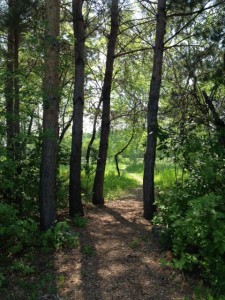 I feel closer to God when I’m in the woods than anywhere else I can think of. Yes, God shows up anywhere (and one of my most meaningful God-experiences was during a three week hospital confinement when I lost my son Matthew), but I have the easiest time quieting my mind and opening my heart when I surround myself with the stillness and beauty that the woods offer me. Add to that the body engagement of walking, and I feel like I’m Eve in the Garden of Eden, walking with God at my side.
I feel closer to God when I’m in the woods than anywhere else I can think of. Yes, God shows up anywhere (and one of my most meaningful God-experiences was during a three week hospital confinement when I lost my son Matthew), but I have the easiest time quieting my mind and opening my heart when I surround myself with the stillness and beauty that the woods offer me. Add to that the body engagement of walking, and I feel like I’m Eve in the Garden of Eden, walking with God at my side.
For three weeks now, I feel like I’ve been banished from the Garden. This broken foot means that I can’t walk and I can’t even drive myself to a place where I can sit at the edge of the woods.
It’s been agonizing. I know it sounds like an over-dramatization, and I know that there are people in the world with much bigger problems than mine, but it’s been really, really hard. Harder than I would have imagined. I am just not good at sitting still.
It’s been especially hard because all of this long hard winter, while I watched my Mom die and my husband come near to death with a heart attack, I kept telling myself “at least it will be Spring soon and I will be able to find some healing in the woods. I will sit on my familiar stone bench and pour out my grief to the birch trees. I will stand on the riverbank and the Dancing Goddess Tree will offer her strength. I will follow the deer into the woods and they will whisper ‘everything is going to be alright’.”
When I first heard the doctor say “broken”, my thought was “does God hate me? WHY?! Why does another shitty thing have to happen just when I felt like I was on the road to healing?”
And then for the next three weeks, I wallowed in the misery of my exile. I tried to turn to my other spiritual practices – I made one pathetic mandala, I wrote a page or two in my journal, and I got halfway through a collage – but nothing worked. Everything just served to make me feel more restless than before. God felt a million miles away, and my wild heart felt frantic, like a caged animal.
On Thursday, the doctor finally said I was free of crutches and could walk reasonable distances on my boot. On Sunday I practically begged my husband, “please drive me to the gate at Henteleff Park, drop me off, and I’ll text you when I’m ready to come home.”
The park gate felt like the door to my cage. Not too many steps down the path and I felt like I had finally come back home. Out of Exile. Back to the Garden of Eden. Back to a place where God walked with me.
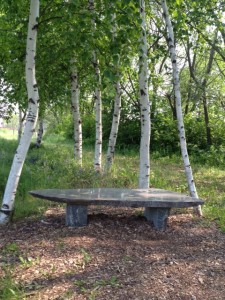 I limped as far as my favourite stone bench in the middle of the birch trees, and I laid down on my back, staring up at the fluttering leaves. The breeze on my face was God’s kiss. The birds sang God’s love song. “Welcome back to the Garden,” they sang. I started to cry.
I limped as far as my favourite stone bench in the middle of the birch trees, and I laid down on my back, staring up at the fluttering leaves. The breeze on my face was God’s kiss. The birds sang God’s love song. “Welcome back to the Garden,” they sang. I started to cry.
I don’t know if there is a “why” for the breaking of the foot. I don’t really believe that “everything happens for a reason and that the universe conspired to break my foot to teach me an important lesson.” I can’t get my head around that kind of fatalism. I do, however, believe that we are meant to work our way through difficult times and then find meaning in the darkness that helps us better understand and appreciate the light. For me, at that moment, lying on my back on a stone bench, feeling like a refugee who’d returned home after a time in exile, I found some profound meaning that was much bigger than a three week period of restlessness.
More than simply a moment in the woods, it suddenly became for me a metaphor for my life. Since that three week period in the hospital more than a dozen years ago, when God showed up in a series of strange and mystical encounters (and during which time I eventually lost my son Matthew), I have been working my way back from exile. In the hospital, after a night of wrestling with God, I woke up to how far away from my authentic Self – my wild heart – I’d become. Like the last three weeks of my life when I couldn’t walk in the woods, I’d been living like a caged tiger, exiled from my home in the wilderness.
There was a void in my life, and I knew it, but instead of trying to break free of the cage by seeking out spiritual practices and meaningful work, I was attempting to fill it with money, a prestigious career, material possessions, food, etc. In the hospital, when all of those things were suddenly unavailable to me, I finally recognized the futility of my search. I suddenly knew that to fill the void, I would need to find the path back to my own wild heart, back to Spirit, and back to a more authentic life. Right then and there, in the hospital waiting for my son to make his appearance, I started that journey and have been on the path (with a few detours now and then) ever since.
A few years ago, when I was beginning to understand the meaning of all that, I read the following quote from Peter Block and knew instantly that he was talking about me.
“Leadership is about rearranging the chairs, getting the questions right, putting citizens in front of each other and then knowing what’s worth focusing on. The leadership I’m longing for is the leadership that says my number one job is to bring people together out of exile, out of isolation, and into connection.” – Peter Block
My experience in the hospital and in the years following, in which I gradually returned from exile by quitting my government job, traveling the world working for the cause of justice in non-profit work, and then quitting that job to teach, write, and host conversations, have been preparing me for the work of bringing people together “out of exile, out of isolation, and into connection.”
Coming out of exile means a returning to that which is authentic in all of us. It’s about living wholeheartedly, in tune with each other and the earth. It’s about being in community and extending love and compassion to each other and to ourselves. It requires of us that we turn away from the destructive, disconnected, disenfranchised lives of independence, competition, and over-consumption. It’s a return to simplicity, a return to our hearts, a return to our bodies, a return to each other, and a return to the wild.
This is the work I do now, and this is what I invite you to in my coaching, writing, teaching, and workshops – a return from exile. I know what it’s like to feel trapped and separated from the one thing that will make you feel whole. I know what it’s like to long for a more authentic way of living. I know what it’s like to feel like you’ve gone so far from home you can never return.
I also know what it’s like to return to the wild and finally feel alive again.
If you’re ready to come back from exile, let me help you. After a busy few months, I am finally accepting new coaching clients. Perhaps you’ll be one of them? Contact me and we can start with an exploratory conversation.
And if you want to be in that circle of chairs that Peter Block talks about, learning more about the kind of leadership that brings people out of exile, join me and my colleagues at a one-day Art of Hosting workshop.
p.s. For the past couple of years, I’ve been working on a memoir about how my time with Matthew changed my life. In recent months, I’ve been stuck, knowing that something was missing. Laying on the bench in the park on Sunday, I think I finally found the thread that will tie the book together.
by Heather Plett | Jun 6, 2013 | Uncategorized
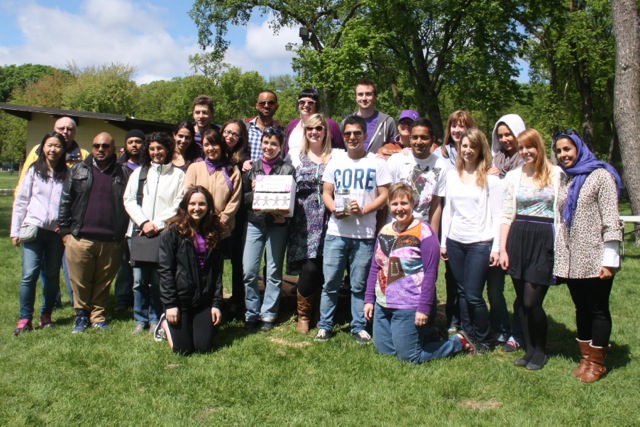
Standing in the park on Saturday, surrounded by my students after the Stand Up Super Games, I got a little choked up. I was immensely proud of this great group of students who’d pulled together, despite some of the rough spots they’d been through, to create a great event for a good cause.
Yes, the students had initiated the event because their assignment in the PR class I teach is to create some kind of PR campaign, but the energy they put into organizing it and fundraising for Osborne House showed that it had become so much more than an assignment; it had become a cause. Most of them showed up in that park not just because they wanted to pass the course, but because they cared for the women taking shelter at Osborne House due to domestic violence.
In showing up for a cause that they care about, my students were demonstrating that they are citizens of the world and they are doing their part in trying to make it better.
In his book, The Abundant Community, Peter Block talks about the difference between citizens and consumers.
“A citizen is one who is a participant in a democracy, regardless of their legal status. It is one who chooses to create the life, the neighbourhood, the world from their own gifts and the gifts of others. A consumer is one who has surrendered to others the power to provide what is essential for a full and satisfied life. This act of surrender goes by many names: client, patient, student, audience, fan, shopper.”
Sadly, there is a tendency in our culture to forget what it means to be citizens and to focus instead on our rights and entitlement as consumers. A recent news story about a man who refuses to mow the lawn on the boulevard in front of his home demonstrates that tendency. He believes it is “the city’s” responsibility to mow that piece of grass, forgetting that “the city” is each and every one of us who live here and that we all have responsibility to care for the place in which we live.
This man is not alone in his sense of entitlement and lack of commitment to the world around him. How often have you heard people complaining about the government, when they do very little to lobby the government for change and often don’t even vote? How often have we ignored the fact that our neighbours may be struggling with poverty or oppression because it’s “not our problem”? How many times do we ignore the damage being done to our earth because we assume we deserve the creature comforts that are produced from the earth’s limited resources?
As a friend living in Haiti reminded me on Facebook this morning when I ranted about this issue, this is the “tragedy of the full belly”. When we have too much, we expect too much. When we become self-reliant, we assume we don’t need other people and that they don’t need us. We stop contributing to our communities because we can get along just fine without them. And when we stop being community-minded, it becomes less and less important how our actions impact the people around us.
That’s why I got emotional when I was standing with my students in the park. In showing up for this campaign, they demonstrated that they haven’t forgotten about the need to contribute to their community. They’re willing to step out of their own comfort zones, forget about their own entitlements, and serve a cause that is bigger than them. This is what we need to foster more of in our schools and work places. This is leadership.
Meg Wheatley defines a leader as “anyone who is willing to show up and help”. Leaders, in other words, are those people who remember their citizenship and are willing to be part of a larger community. The students who contributed to the Stand Up Winnipeg campaign are willing to stand up and be leaders.
The more I do this work, the more I feel passionate about the need for us to stop being so focused on ourselves and our entitlements and start serving as citizens and stewards of the world. That’s why I’m so excited about the three upcoming events I’ll be co-hosting this summer.
On July 6, I’ll be in Ontario co-hosting Ignite: A day of retreat for women sparking change. On July 24, I’ll be in Winnipeg co-hosting The Art of Hosting and Harvesting Conversations that Matter. And then on August 1-4, I’ll be in Asheville, North Carolina, co-hosting Engage! A retreat for women with love in their hearts and fire in their veins.
All of these events are designed for people, like my students, who want to stand up and be counted, people who are willing to be citizens of the world, people who understand that communities thrive when each person shows up and makes a contribution.
These events are not about the old understanding of the leader as a hero, they are about a new understanding of the leader as a host. A host shows up and makes people feel comfortable. S/he engages people in meaningful conversation. S/he makes sure there is good food to eat. S/he is a steward of the place in which she lives. S/he builds community, not from the front of the room but from a place in the circle.
STAND UP now, and let’s make the world a better place.
by Heather Plett | Apr 23, 2013 | Leadership, Uncategorized
“I’m finally beginning to realize that I’m a leader.”
Those are the words I heard not long ago from a woman who’d just finished the four month leadership program I was co-facilitating. She was an incredible woman doing great things in her community, including lobbying to save a local nature trail, but she’d never thought of herself as a leader.
I hear those words all the time, especially from women. I’ve been hearing them recently in relation to my online course Lead with Your Wild Heart. “I love your program… but… I’m not sure I’m a leader.” Almost without fail, these women are gifted in art, teaching, community transformation, homemaking, earth stewardship, etc., and yet they don’t see leadership in what they do.
Part of the purpose of Lead with Your Wild Heart is to re-imagine leadership for our time. I believe that the need in the world has changed and that we now need to see leadership through a new lens.
I believe that the leaders the world needs now are those who know how to host conversations, imagine change, paint, dance, sing, write poetry, love generously, live in right relationship with the earth, build community, imagine new ways of using and honouring our limited resources, teach, and play.
As Margaret Wheatley says, a leader is “anyone who is willing to help.” The world needs us to show up and help right now, with whatever gifts we have to offer.
I’ll be hosting a free call on Wednesday, May 1st, at 2 p.m. Central on Re-Imagining Leadership for Our Time.
The call will be an exploration into a new way of defining leadership that fits the paradigm we are now living in. Your questions and ideas on the subject will be more than welcome. One of my deepest beliefs about effective leadership is that it involves hosting meaningful conversations that help surface the wisdom in the circle. Your wisdom is welcome in this circle, and so are your doubts, questions, and curiosity.
I’m happy to be joined in the call by some of the members of my Wise Heart Wisdom Circle. Those who’ve confirmed so far are Desiree Adaway, Julie Daley, and Lisa Wilson.
Sign up below and you’ll receive the call information in your inbox. I look forward to our conversation!
ALSO… over on Facebook, I’m collecting “what if” questions about leadership to inspire us for the conversation. Scroll down below the sign-up form to see the ones already gathered, and add your own to the comments of this post.

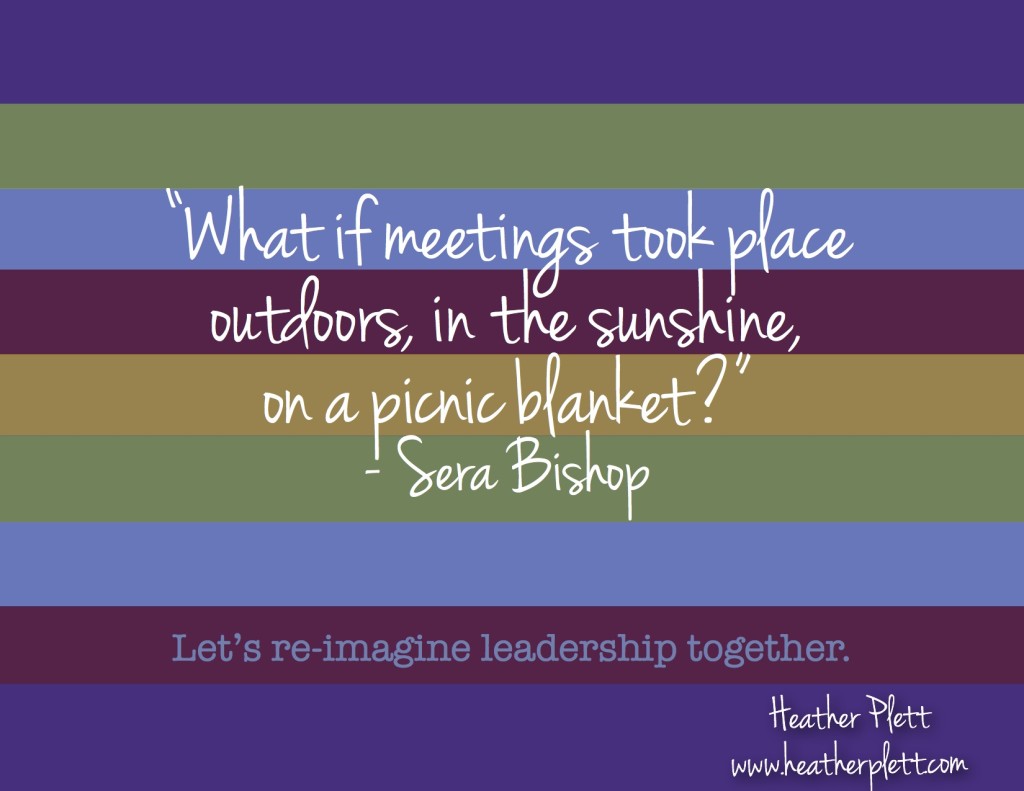
by Heather Plett | Apr 5, 2013 | Creativity, growth, journey, Leadership
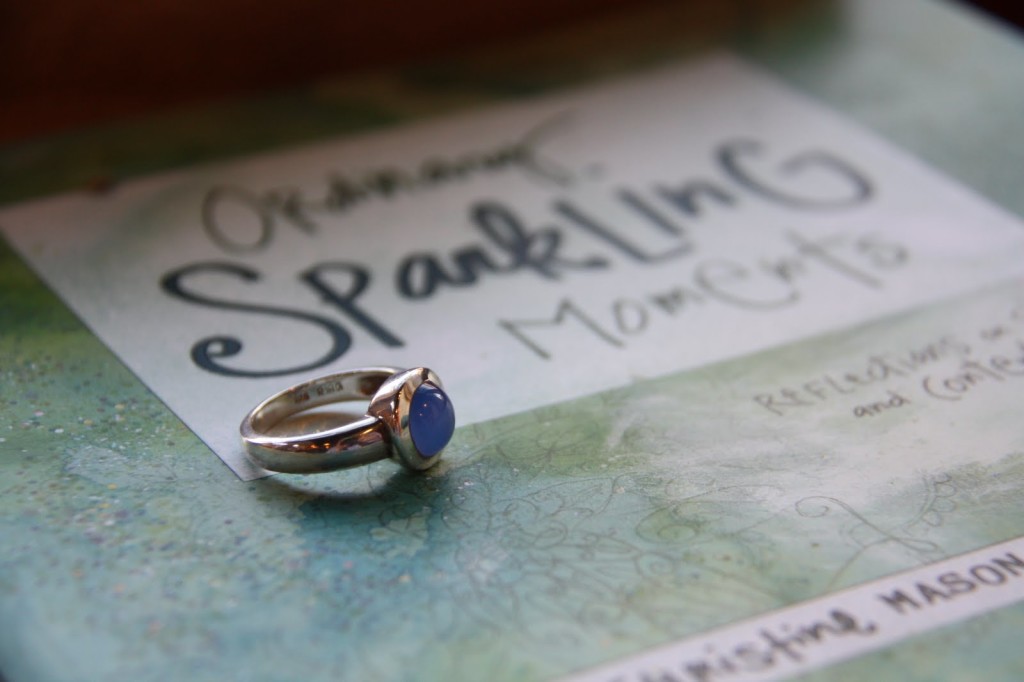
Three and a half years ago, I brought myself a promise ring.
I was visiting Banff at the time, after a business-related road trip through Western Canada. Visiting Banff always brings up mixed emotions for me. I love the beauty of the place, in the middle of the Rocky Mountains, but it holds a sad story from my past. I lived there the summer I turned 19, and it wasn’t a particularly happy summer. I was in that “trying to decide whether to stay safe in life or to take more chances and risk getting hurt” phase of early adulthood. Sadly, I let the things that happened to me that summer convince me that safe was a better option. I gave up the plans I’d had to change schools and move to another province and I went back home to nurse my wounds and play it safe.
One of the places that always brings up deep longing for me is the Banff Centre. When I lived there, my roommates and I sometimes went to watch visiting performers, and each time I went, I’d think “oh, if only I were talented enough to spend time at a place like this!”
When I visited three and a half years ago, I drove past the Centre and started to cry. I cried for the young woman I was more than twenty years earlier who believed she wasn’t talented or worthy. I cried for the hurts that young woman had already suffered and had yet to suffer. I cried for the long journey I’ve had since then, learning to trust both my worthiness and my longings, and learning to be both resilient and courageous through the hard times.
When I drove back into town after visiting the Centre and the resort where I spent the summer cleaning other people’s mess out of hotel rooms, I wandered through the downtown and dropped in at a jewellery store. In a flash of inspiration, I bought myself a promise ring with a blue chalcedony stone. (I later learned that the chalcedony speaks of spirit and trust and is known as the Speaker’s Stone, the stone of one who must measure his words. It encourages reflection and meditation, its gentle radiance preparing us for action but helping to hold back words we might regret. The great Roman orator, Cicero, is said to have worn one around his neck.)
Later that day, I sat in a cafe with my journal and wrote the following promise to myself:
I promise:
– I will take more chances.
– I will believe that I am an artist.
– I will trust my ability.
– I will look for opportunities to paint and make art as often as I can.
– I will sign up for another class or workshop that stretches me.
– I will honour the muse.
I couldn’t go back and make those promises for my 19 year old self, but it wasn’t too late to make them for my 40+ self.
Last week, in the last lesson for Lead with Your Wild Heart, I invited participants to make a commitment to themselves and to honour it with some kind of gift, like a ring. That tweaked my memory and I went back to find the original post I wrote about the promise ring I’d bought for myself. I started crying all over again – not because I was sad anymore for my 19 year old self, but because I am delighted for my 46 year old self that I can honestly say that I have kept my promise to myself.
I have done just what I said I’d do. I took more chances (quit my job and started a business), started making more art and taking art classes, I’ve been honouring the muse, and trusting my own ability.
Nothing to date has felt so much like an honouring of that promise as the creation of Lead with Your Wild Heart. Nothing has felt so much like it is emerging out of my most authentic, most beautiful, most Spirit-guided self.
I’ve just opened registration for the second offering of Lead with Your Wild Heart, and I can say that I am thrilled beyond expectation with how beautifully it has turned out. This has been an exercise in trusting my own wild heart, and I know that it will serve as a gift to all those who take it into their own wild hearts.
And now… can I tell you a little secret? I’m dreaming of taking some version of Lead with Your Wild Heart to the Banff Centre for Leadership Development. I don’t know yet how to make that happen, but I’m sharing the dream in hopes that will help me get closer to it.
I’m trusting my wild heart and seeing where it leads.
by Heather Plett | Feb 6, 2013 | change, circle, Creativity, Leadership, women
I have the great privilege these days of co-hosting a women’s leadership program that meets every second week in a small town an hour and a half from the city where I live. There are so many things about this that I love, including the fact that I have a regular reason to drive out into the country and see the wide open prairies and the wild, alluring woods. With no parents left to visit, I don’t get out to my rural roots often enough to suit me.
On the drive out there yesterday, we had a rare and wonderful sighting of a lynx as it dashed across the road and ran off into the snowy woods. It felt like a moment of blessing.
Yesterday’s session focused on facilitating change. The best change process I know of is Theory U, a process I was first immersed in at ALIA Summer Institute and that I’ve been a dedicated student of since.
I introduced the idea of a Change Lab, where-in we would walk through the U process by casting ourselves in the role of community leaders who recognize the need for change in how the community is organized.
I started out by sharing the story of Baba Yaga’s House in Paris, France, a home created for aging feminists by a circle of women who realized that none of the available models for seniors’ housing fit with their values or expectations of how they wanted to live. (I encourage you to listen to the podcast at the link above.) “Imagine we are these women,” I said. “We are faced with an established community model we know doesn’t work for us, and yet we haven’t found a new model that we’re comfortable with.”
From there I moved on to an explanation of Theory U, a method for co-creating social change. Instead of trying to find a direct route from challenge to solution – the way some of the more linear models do, with brainstorming, strategic planning, etc. – Theory U takes us on a deep dive into the unknown. Instead of trying to direct change, we host what is wanting to be born. Instead of trying to control, we let go and let come. Instead of expecting the future to look like the past with just a few tweaks, we invite a new future to spiral up out of the brokenness of the past.
 In Theory U there are three main parts – sensing, presencing and realizing. In the sensing phase, we are invited to use all of our senses to witness what is present. We are invited to suspend our judgements, opinions, assumptions and mental models, and to use our eyes and ears and the feeling of our bodies to sense into whatever the context is. We host conversations, we ask good questions, we listen deeply, we watch with full attention, and we notice how our bodies feel.
In Theory U there are three main parts – sensing, presencing and realizing. In the sensing phase, we are invited to use all of our senses to witness what is present. We are invited to suspend our judgements, opinions, assumptions and mental models, and to use our eyes and ears and the feeling of our bodies to sense into whatever the context is. We host conversations, we ask good questions, we listen deeply, we watch with full attention, and we notice how our bodies feel.
In the presencing phase, we are invited into the inner work of grounding ourselves in our bodies and paying attention to what is emerging. We listen into the space and learn from the future as it emerges, letting go of our expertise and experience. Rather than moving directly into problem solving or brainstorming, we take time for retreat and reflection. The best place for presencing is outside in nature where we ground ourselves in the earth and lean into the trees.
The third phase is Realizing. In this phase – on the upward movement out of the U – we “let come” what wants to emerge. We bring insights, sparks of inspiration, and crystals of ideas into prototypes. We move into action quickly and create small projects that can move the vision forward.
When I introduced Theory U to a women’s circle in Ontario last year, someone pointed out that I’d just drawn a woman’s breast. She said it with laughter, but when we started to unpack that, we realize that there was resonant truth to what she witnessed. This process definitely has a feminine aspect to it (as is laid out in this article by Arawana Hayashi) and it relates well to an infant suckling at the source of his/her life. It’s about going back to Source, it’s about seeking nurturing and rebirth, and it’s about the kind of rest and retreat that a mother must seek every few hours when an infant needs to suckle. It’s about being innocent, vulnerable, uneducated, without judgement, and open to a new future, just like that tiny baby. Since that first observation, I’ve brought up the idea every time I introduce it, and it always opens up interesting dialogue.
Once I had introduced the Theory, it was time to move into practice. To start with, I did one of my favourite things to do in workshops – I dumped a pile of garbage on the floor (things I’d gathered from my household recycling bin). “This,” I said, “represents the chaos and brokenness of the systems that no longer work for us. Out of this, something new wants to emerge, but we don’t yet know what it is. It will be up to us to host that new thing into being, without relying on what was or casting judgement on the ‘way it’s supposed to be’.”
In the Sensing phase, I asked them to sit in one-on-one conversations with a few different people in the room. “Ask deep questions, explore what is present, and use your senses to witness what is. Suspend judgement and don’t rely on past or second-hand information.”
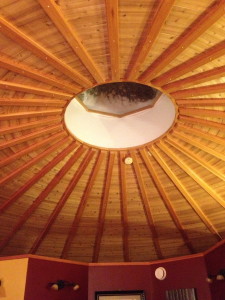 After a few rounds of conversation (too short, but all the time we had), they were invited to move into Presencing. “If it weren’t a cold winter night outside,” I said, “I’d encourage you to move outside for this part. Instead, find a quiet place inside where you can be alone with your thoughts and with whatever wants to emerge.” (As an aside, it felt beautifully appropriate that we were gathered inside a mandala home, a circular home built with great intention around honouring the four directions, giving space at the centre, and blending into the beauty of nature that surrounds it.)
After a few rounds of conversation (too short, but all the time we had), they were invited to move into Presencing. “If it weren’t a cold winter night outside,” I said, “I’d encourage you to move outside for this part. Instead, find a quiet place inside where you can be alone with your thoughts and with whatever wants to emerge.” (As an aside, it felt beautifully appropriate that we were gathered inside a mandala home, a circular home built with great intention around honouring the four directions, giving space at the centre, and blending into the beauty of nature that surrounds it.)
The next phase brought them back to the garbage on the floor, where they began to explore what wanted to emerge. Some felt stuck and really didn’t connect right away with the garbage on the floor. Others were eager to jump in and host the emerging future. Before long, though, everyone had made a valuable contribution to the scale model of the new community that wanted to be born.
We spread our community out on a large piece of cardboard on the table. Some pieces represented a connection with nature, others represented a connection with our neighbours, others represented a connection with opportunities/arts/beauty/etc., and still others represented a deeper connection with self and the sacred.
When we sat discussing the panorama in front of us, we realized that the resounding theme of what was emerging was connection. We were all longing for connection – with each other, with the earth, with the water, with the Sacred, and with ourselves.
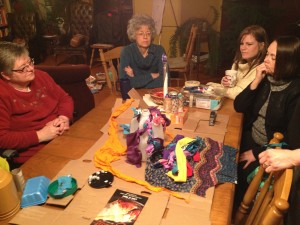 One woman asked “If recycling is the bi-product of a culture of consumption, what can replace consumption as our dominant paradigm that will no longer have a requirement for recycling?” Connection, we agreed. We need deeper connection.
One woman asked “If recycling is the bi-product of a culture of consumption, what can replace consumption as our dominant paradigm that will no longer have a requirement for recycling?” Connection, we agreed. We need deeper connection.
Before we departed for the night, I invited the women to consider (in their private moments, when they were back in their homes) “How might each of us be ambassadors for connection in our communities? How might we begin to invite this future into the circles in which we live?”
The women left with new lights in their eyes that hadn’t been there when they’d entered the room – all because of a pile of garbage and a time of connection.
(Next week’s session flows beautifully out of this… We’ll be talking about making connections in women’s leadership circles, using the new toolkit created by my teachers Christina Baldwin, Ann Linnea, and Margaret Wheatley.)
Note: If you want more inspiration on this, visit Presencing Institute, read Theory U, Presencing, or Walk Out Walk On.
 I feel closer to God when I’m in the woods than anywhere else I can think of. Yes, God shows up anywhere (and one of my most meaningful God-experiences was during a three week hospital confinement when I lost my son Matthew), but I have the easiest time quieting my mind and opening my heart when I surround myself with the stillness and beauty that the woods offer me. Add to that the body engagement of walking, and I feel like I’m Eve in the Garden of Eden, walking with God at my side.
I feel closer to God when I’m in the woods than anywhere else I can think of. Yes, God shows up anywhere (and one of my most meaningful God-experiences was during a three week hospital confinement when I lost my son Matthew), but I have the easiest time quieting my mind and opening my heart when I surround myself with the stillness and beauty that the woods offer me. Add to that the body engagement of walking, and I feel like I’m Eve in the Garden of Eden, walking with God at my side. I limped as far as my favourite stone bench in the middle of the birch trees, and I laid down on my back, staring up at the fluttering leaves. The breeze on my face was God’s kiss. The birds sang God’s love song. “Welcome back to the Garden,” they sang. I started to cry.
I limped as far as my favourite stone bench in the middle of the birch trees, and I laid down on my back, staring up at the fluttering leaves. The breeze on my face was God’s kiss. The birds sang God’s love song. “Welcome back to the Garden,” they sang. I started to cry.






